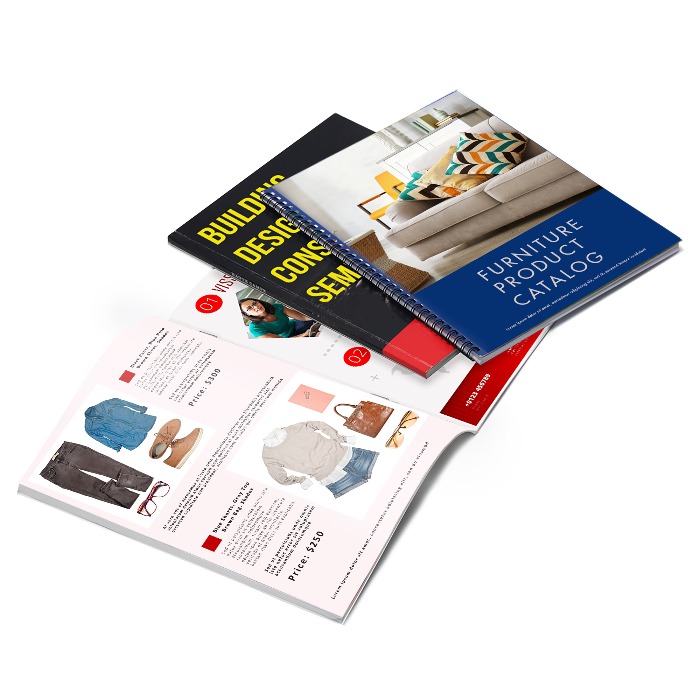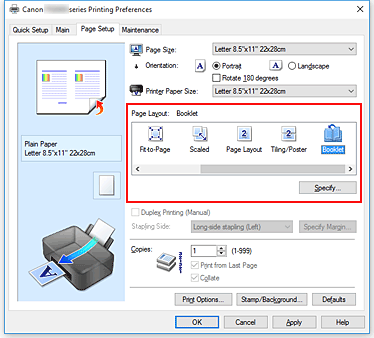How Booklet Printing Supports Omni-Channel Marketing Strategies
The Necessary Overview to Recognizing Pamphlet Printing Options and Techniques
The procedure of brochure printing involves multiple factors to consider that can greatly influence the end product. From selecting the suitable layout and dimension to comprehending the nuances of binding techniques, each option plays a crucial function. Furthermore, factors such as paper supply and printing methods further affect the performance of the brochure. As one navigates these options, it becomes vital to understand just how they adjoin and what that indicates for the overall outcome.
Recognizing Brochure Sizes and styles
When thinking about pamphlet printing, comprehending the numerous formats and dimensions available is important for achieving the preferred presentation. Booklets can be created in many layouts, including saddle-stitched, spiral-bound, and perfect-bound, each offering distinctive advantages. Typical dimensions vary from common letter (8.5 x 11 inches) to smaller choices like A5 (5.8 x 8.3 inches), permitting adaptability based upon material and target audience.Selecting the suitable size can influence both the design and viewers interaction. Larger dimensions might suit aesthetically driven content, while smaller styles might be much more user-friendly and mobile. In addition, the number of web pages impacts the selection of binding approach, as thicker booklets may need stronger bindings. Inevitably, understanding these aspects enables a much more customized technique, making sure that the last item aligns with the designated message and visual, enhancing the overall efficiency of the communication.
Picking the Right Paper Supply

Binding Approaches: Options and Considerations
When it pertains to binding approaches for booklets, several alternatives are available, each with unique benefits. Saddle stitch binding supplies an affordable option for thinner pamphlets, while best binding techniques provide an even more refined search for thicker publications. Wire-O binding sticks out for its toughness and simplicity of use, making it perfect for files that need versatility.
Saddle Stitch Binding
Saddle stitch binding supplies a practical and cost-effective solution for assembling booklets, making it a popular choice among publishers and services. This binding technique involves folding sheets of paper in fifty percent and stapling them along the fold line, developing a cool and well organized appearance. Typically suitable for booklets with a reduced web page count, saddle sewing is optimal for magazines, brochures, and instructional products. The simpleness of this technique allows for fast manufacturing and is commonly favored for marketing items or brief runs. It is crucial to keep in mind that saddle stitch binding may not be appropriate for thicker pamphlets, as the back might not hold up under enhanced weight. In general, it stays a trustworthy choice for many printing tasks.
Perfect Binding Methods
Perfect binding is a commonly utilized strategy that supplies a professional and refined finish to brochures and publications. This method entails gluing the web pages with each other at the back making use of a strong adhesive, permitting for a clean edge and the capability to hold a larger number of web pages contrasted to saddle sewing. Perfect binding is especially ideal for thicker booklets, such as directories and annual records, where a durable, level spine is preferred. In addition, it provides the option for a published cover that can be developed to boost aesthetic appeal. Considerations such as page count, paper weight, and the planned use of the pamphlet should be taken right into account, as they can impact longevity and overall high quality.
Wire-O Binding Alternatives
Wire-O binding, recognized for its resilience and flexibility, supplies an excellent option for brochures that need easy page transforming and a professional appearance. This binding method utilizes a series of metal loops that hold pages securely, allowing them to lie flat when open. It is particularly appropriate for guidebooks, magazines, and discussions because of its durable nature. Wire-O binding is offered in various colors and sizes, fitting different web page matters and densities. Furthermore, it permits the inclusion of tabs and covers, improving the pamphlet's total aesthetic. Considerations for Wire-O binding include the option of wire color, the dimension of the loopholes, and the extent of customization wanted, every one of which can exceptionally influence the last product's look and functionality.
Digital vs. Offset Printing: Which Is Best for You?
When selecting a printing approach for brochures, understanding the distinctions between electronic and balance out printing is vital. Digital printing utilizes modern-day technology to produce high-grade prints swiftly and economically, making it ideal for brief runs or projects calling for quick turn-around times. It permits customization, supplying the ability to publish on-demand with minimal waste.In comparison, balance out printing is a traditional technique that excels in generating large amounts with consistent top quality. It involves moving ink from a plate to a rubber blanket, then to the paper, which leads to vivid colors and specific details. However, balance out printing generally calls for longer arrangement times and is much more cost-efficient for larger volumes.Ultimately, the option in between digital and counter printing relies on project demands, spending plan, and wanted amount. For small, time-sensitive jobs, electronic could be the ideal choice, while offset may be more suitable for larger, top notch productions.

Creating Your Pamphlet: Tips and Best Practices
When creating a brochure, cautious attention to format, typeface option, and shade use can significantly enhance its performance. A well-structured format Click This Link overviews the visitor's eye, while suitable fonts guarantee readability and share the desired tone. Additionally, reliable use color can evoke feelings and highlight essential details, making the total style more impactful.
Picking the Right Format
Exactly how can one efficiently choose the appropriate design for a booklet? Initially, it is necessary to review the brochure's function and target audience. A clean, organized design improves readability and engagement. Making use of a grid system can help in aligning aspects consistently, producing a specialist appearance. Additionally, including visual pecking order through varying dimensions and placements of photos and message can direct the viewers's eye and stress vital details. It is also crucial to leave enough white area, which protects against overcrowding and enables better focus. Finally, checking various layouts with mock-ups can give insight into how the design performs in real-world situations, making certain that the end product fulfills both useful and visual requirements.
Picking Ideal Font Styles
An appropriate font can greatly enhance the general style of a brochure, enhancing the format and enhancing the web content's message. The selection of fonts should consider readability, especially for body message, as it assures the information is accessible to all visitors. Sans-serif font styles are often preferred for electronic styles, while serif font styles can provide a typical feel in published products. It's suggested to limit font choices to two or 3 to preserve aesthetic comprehensibility. Furthermore, font style dimension plays a vital role; this website headings must be not frustrating but distinctive, while body message must fit for reading. When picking font styles, positioning with the booklet's motif and target market is necessary for efficient communication and visual charm.
Reliable Use Shade
Color acts as a powerful tool in booklet style, leading and shaping understandings viewers emotions. It can stimulate feelings of peace, trust, or enjoyment, depending on the colors selected. Designers must consider color concept principles, ensuring that the selected scheme aligns with the brochure's message and target market. Using warm colors like red and orange can produce seriousness, while cooler tones like blue and green foster tranquility.Additionally, comparison plays a vital role; complementary colors can enhance readability and visual charm. Uniformity in shade use throughout web pages better reinforces brand name identification and cohesion. Eventually, reliable color application not just captures interest yet also enhances the booklet's objective, making it a vital aspect of successful layout.
Ending Up Touches: Coatings and Unique Results
While numerous think about the material and layout of a booklet the most critical components, the ending up touches, such as coatings and unique impacts, play a necessary function in enhancing its overall charm. Coatings can offer protection and resilience, guaranteeing that the booklet holds up against damage. Matte coatings provide an advanced, non-reflective surface, while shiny finishings can make colors show up more vibrant and eye-catching. Special results, like embossing or foil marking, include a tactile dimension that can develop an unforgettable impact. These methods can highlight details areas, drawing interest to important details or creating aesthetic rate of interest. Additionally, UV layer can supply a high-shine finish that raises the overall look.Together, these ending up touches not only boost the pamphlet's visual but likewise interact professionalism and trust and focus to detail, inevitably leaving a long lasting impact on the visitor.
Price Considerations for Brochure Printing
Understanding the different expense factors to consider for brochure printing is important for organizations and organizations aiming to enhance their spending plans. Key variables affecting prices consist of the choice of ink, paper, and binding methods. Better products, such as exceptional paper or specialized inks, normally raise the overall cost. In addition, the dimension and page count of the booklet play a substantial duty; larger booklets require more sources and time to produce.Another crucial consideration is the printing technique, whether electronic or countered, as each has its own rates structure and suitability for various quantities. Services must additionally consider layout prices, which can differ based on complexity and making use of professional services. Ultimately, delivery and handling fees can include in the total, especially for large orders. By assessing these elements, organizations can make informed decisions that line up with their financial abilities while accomplishing the desired quality in their printed products.
Regularly Asked Inquiries
What Are the Ecological Effects of Booklet Printing?
The environmental impacts of pamphlet printing consist of logging from paper manufacturing, carbon exhausts from transportation, and waste generation from thrown out products - Booklet Printing. Sustainable practices, such as using recycled paper and green inks, can minimize these results
Exactly How Can I Guarantee Shade Precision in My Brochure?
To guarantee shade accuracy in a booklet, one need to use calibrated displays, use specialist color accounts, carry out test prints, and pick top notch printing solutions that supply color matching and proofing options for finest results.
What Is the Common Turnaround Time for Booklet Printing?
The normal turn-around time for pamphlet printing differs depending upon the complexity and quantity - Booklet Printing. Generally, it ranges from a few days to 2 weeks, influenced by factors such as printing approaches and ending up demands
Are There Minimum Order Quantities for Pamphlet Printing?

Can I Print Brochures in Multiple Languages?
Printing brochures in several languages is feasible. Several printing solutions offer options for multilingual or bilingual designs, enabling effective interaction. Mindful planning assurances that create components suit numerous languages without endangering readability or visual appeals. Furthermore, variables such as paper stock and printing techniques further influence the effectiveness of the pamphlet. When taking into consideration pamphlet printing, recognizing the different styles and sizes available is vital for accomplishing the preferred discussion. When picking a printing approach for brochures, comprehending the differences between digital and counter printing is essential. In addition, the dimension and page count of the pamphlet play a substantial duty; larger booklets call for more resources and time to produce.Another important factor to consider is the printing method, whether digital or balanced out, as each has its very own rates structure and suitability for different quantities. The ecological effects of booklet printing consist of logging from paper manufacturing, carbon exhausts from transport, and waste generation from disposed of products.